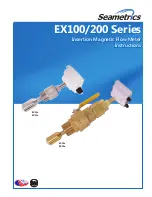
EX100/200 SERIES INSTRUCTIONS
Seametrics • 253.872.0284
Page 5
seametrics.com
Positioning the Meter
For best results, the EX100/200 sensor should be
installed with at least ten diameters of straight pipe
upstream and five downstream. Certain extreme situations
such as partially-opened valves are particularly difficult and
may require more straight diameters upstream (see page 9
for straight pipe recommendations).
Distorted Flows
Horizontal (3 o’clock or 9 o’clock position) is the preferred
installation orientation, since it improves low-flow
performance and avoids problems with trapped air and
sediment. (See Orienting the Meter diagram below.) Bottom
(6 o’clock), top (12 o’clock), and vertical pipe installations
are all acceptable if required by the piping layout.
Orienting the Meter
FLOW
Faster Flow
Causes Meter
To Read High
10X
5X
Distorted
Flow Profile
Fair
Unacceptable if pipe
contains air
Best
Position
Fair
Unacceptable if pipe
contains sediment
Caution
: These flow sensors are
not recommended for installation
downstream of a boiler feedwater pump
where installation fault may expose the
flow sensor to boiler pressure and temperature.
Maximum recommended temperature is 200°F.
INSTALLATION
Caution
: In chemical injection or
fertigation applications, install chemical
line downstream of magmeter, or far
enough upstream to allow complete
mixing of fluids before the meter.
Immersion
The 100/200-Series sensors are not designed for underwater
operation. Even occasional immersion can cause damage.
If occasional immersion, such as when a vault floods, then
the -40 option, (immersion) is recommended.
Chemical Injection or Fertigation
When a magmeter is used in a chemical injection application
(including fertigation), the chemical line must be placed
downstream of the magmeter OR far enough upstream
for complete mixing to occur before the fluid reaches
the meter. When unmixed chemical or fertilizer alternates
with water passing through the meter, the rapid changes
in conductivity may cause sudden spikes and drops in the
meter’s reading, resulting in inaccurate measurement. The
magmeter will restabilize, however, with a steady flow of
fluid of uniform conductivity.




















